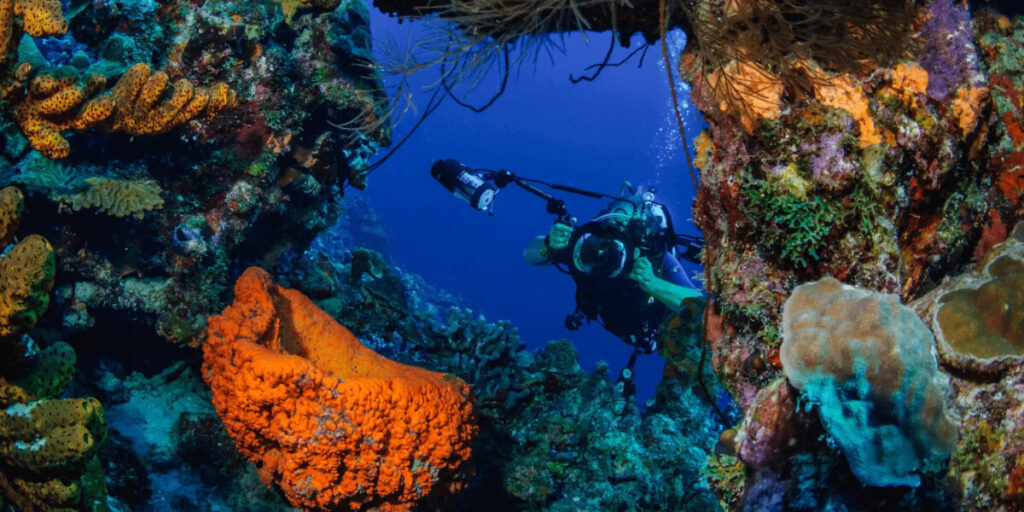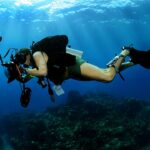Diving in Komodo National Park is a dream for underwater enthusiasts. Imagine gliding through crystal-clear waters, surrounded by vibrant coral reefs teeming with life, and encountering majestic creatures like manta rays and Komodo dragons. But the magic doesn’t stop there. Komodo offers a hidden world of unparalleled beauty, waiting to be revealed by the keen eye of a macro photographer.
Transitioning from wide-angle landscapes to the intimate realm of macro photography requires a shift in mindset and technique. Explore essential tips to help you capture stunning close-up images during your diving adventures in Komodo.
Choosing the Right Equipment: Gearing Up for Macro Magic
Camera and Housing:
- Mirrorless cameras: Many advanced mirrorless cameras offer excellent image quality and compact size, which is ideal for underwater maneuverability.
- DSLRs: While bulkier, DSLR cameras with dedicated macro lenses can provide superior image quality for seasoned photographers.
- Housing: Choose a housing specifically designed for your camera, ensuring watertightness and functionality of all controls.
Macro Lenses:
- Dedicated macro lens: Invest in a lens with a magnification ratio of at least 1:1, allowing you to capture life-size images of tiny subjects.
- Wet diopters attach to your existing lens to increase magnification without sacrificing image quality.
Additional Gear:
- Macro port: This attaches to your housing, minimizing water distortion and improving image sharpness.
- Flashes and diffusers: External flashes illuminate subjects in low-light environments, while diffusers create soft, even light.
- Tripod or buoyancy arms stabilize your camera for sharp, blur-free macro shots.
Remember: Komodo National Park regulations restrict certain equipment like rebreathers. Ensure you comply with all rules before diving.
Read More Articles:
How Citizen Science Enhances Your Komodo Liveaboard Journey
The Challenges of Conserving the Dragons in Komodo Island
Mastering the Art of the Small: Essential Techniques

Focus and Composition:
- Manual focus: Autofocus struggles in macro photography. Practice manual focus to ensure critical sharpness on your chosen subject.
- Fill the frame: Get close! Macro photography thrives on filling the frame with your subject, emphasizing its intricate details.
- Rule of Thirds: Compose your image using the rule of thirds to create visually appealing and balanced compositions.
Light and Exposure:
- Experiment with lighting: Utilize natural light, external flashes, or a combination of both to achieve desired lighting effects.
- Aperture control: Use a small aperture (high f-number) for maximum depth of field, ensuring all details are sharp.
- Shutter speed: Adjust shutter speed based on lighting conditions and desired motion blur effect.
Patience and Observation:
- Slow down and observe: Macro photography is a game of patience. Take your time to study your subject and anticipate its movements.
- Respect the environment: Komodo’s marine life deserves respect. Avoid touching or disturbing creatures; opt for natural poses over staged shots.
Remember: Always prioritize diving safety and responsible underwater practices while pursuing your photography passion.
Diving in Komodo: Sites and Subjects for Macro Magnificence
Komodo National Park offers diverse dive sites teeming with macro subjects waiting to be discovered.
- Manta Point: While known for majestic manta rays, this site boasts pygmy seahorses, nudibranchs, and colorful reef fish.
- Batu Bolong: This current-swept wall offers encounters with ornate ghost pipefish, frogfish, and colorful shrimp.
- Crystal Rock: Explore coral bommies teeming with nudibranchs, flamboyant cuttlefish, and playful shrimp gobies.
- Makassar Reef: This vibrant reef harbors a plethora of macro wonders, including pygmy seahorses, colorful crabs, and anemonefish guarding their homes.
Remember: Research dive sites and their specific regulations before venturing out. Some areas have restrictions on photography.
Beyond the Basics: Advanced Methods for the Ambitious
- Creative cropping: Use software to crop your image tightly, highlighting the most captivating details.
- Focus stacking: Combine multiple photos with slightly different focus points to achieve maximum sharpness throughout the subject.
- Background manipulation: Blur the background with software to isolate your subject and create a sense of depth.
Diving in Komodo: An Unforgettable Macro Journey
With its diverse marine life and stunning coral reefs, Komodo National Park offers a unique opportunity to delve into the fascinating realm of macro photography. Following the tips and techniques discussed here, you can capture stunning close-up images that showcase the hidden wonders of this underwater paradise. Remember, respect and responsible diving practices are key to unlocking the true beauty beneath the waves. So, grab your camera, gear up, and prepare to be amazed by the magic of macro photography in Komodo!
